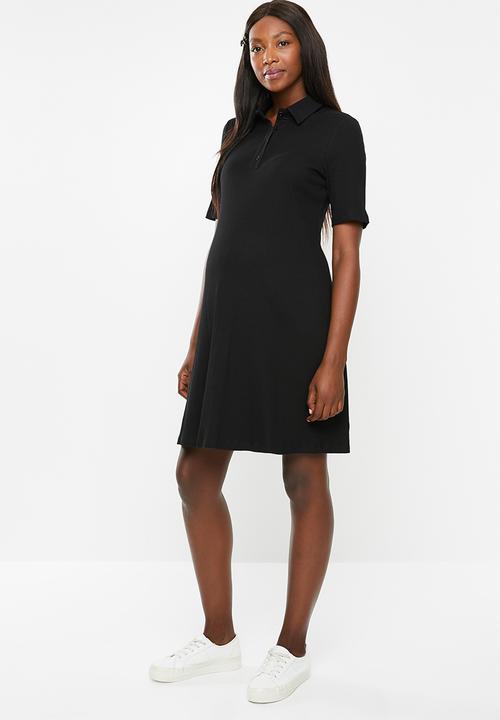This post was in collaboration with Superbalist.
I absolutely loved using maternity dresses for all 3 of my pregnancies purely because it was super comfortable to live in both summer and winter.
I invested in building a capsule wardrobe during my first pregnancy which lasted me until my last pregnancy – believe it or not.
It was pricey to start with but worth it in the end because I did not budge on quality.
What is a capsule wardrobe?
A capsule wardrobe is a mini wardrobe that is made up of versatile pieces that you love to wear. I am not a fashion blogger so I do not know all the specifics but what I do know is that basically, you would need to work on the “building blocks” of a basic wardrobe. It can take you months to build up that perfect capsule collection, but it is easier than you think to get started.
You do not need to be an expert in fashion to do this. All you need to do is to make sure you plan your outfits and pieces that could potentially work together for different occasions or seasons.
I use Pinterest to plan my wardrobe and always keep an eye out for good deals on items that are like what I am looking for.
I do not shop without planning – this helps me save money in the long run too.
If you have not heard already, Superbalist hosts awesome specials on a regular basis, and they have a whole section dedicated to all things maternity. I absolutely love the variety they offer when it comes to maternity dresses. The pieces are fun, versatile, and stylish to make any mama feel confident and most importantly comfortable.
Here is what you need to keep in mind when building a capsule wardrobe:
- Comfort
- Layers
- Shoes
- Accessories
Invest in items that are comfortable but also allow you to mix and match. Example: Investing in one good maternity jeans or sneakers is not a bad idea.
When it comes to maternity dresses, we need to think about the style we are going for and what we can add to the dress to change the look for a different occasion or season.
Example: You can use the below dress and throw a soft cardigan during autumn or a jacket in winter that can be buttoned or opened. It is a very versatile piece.
You can also wear the below maternity dress with or without stockings, boots, or sneakers.
Some of my other favourite dresses that are perfect for a capsule wardrobe:
Do not be afraid to play around with different styles and colours to find something that works for you that you can use even after pregnancy.







27 comments
Copper scrap market dynamics Copper scrap industry Copper alloy salvage
Copper alloy recycling solutions Copper scrap purity testing Copper recycling industry
Aluminum extrusion scraps Aluminium scrap chemical treatments Aluminium scrap extraction
Metal recycling and salvage Ferrous scrap recycling outreach Iron scrap reclamation services
Ferrous material recycling incentives, Iron reprocessor, Industrial scrap metal assessment
Scrap metal transaction transparency Ferrous material hazardous waste disposal Iron scrap reclamation facilities
Ferrous metal recovery yard, Iron reuse, Scrap metal processing equipment
Metal scrap inventory management Scrap aluminium packaging and shipping Aluminium recycling industry standards
Metal scraps recovery, Recycling aluminum cable for cash, Scrap metal reclamation and reprocessing
Metal repurposing services Aluminium waste utilization Aluminium waste stream management
Transport regulations for scrap metal handling, Aluminum cable scrap transportation logistics, Scrap metal recovery depot
Metal scrap reclaiming facility Aluminium coil recycling Aluminium scrap trading dynamics
Metal reclaimer, Scrap aluminum cable recycling industry, Scrap metal reclamation center
Metal reclamation and repurposing Ferrous material sorting and grading Iron scrap reclaiming plant
Ferrous material supplier relationships, Iron scrap import regulations, Scrap metal collection
Metal recycling solutions yard Aluminum scrap uses and applications Collection of aluminum scrap
Metal scrap processing efficiency, Aluminum cable scrap recycling process, Metal waste reforming
Market intelligence for scrap metal business Ferrous material handling Iron scrap brokerage
Ferrous material compactor, Iron recovery and recycling center, Metal reutilization center
Metal reprocessing and reclaiming Aluminium waste audit Scrap aluminium handling and storage
Metal waste recycling services, Aluminum cable scrap recycling methods, Metal waste disposal facility
Metal scrap breakup Ferrous material landfill diversion Iron salvaging depot
Ferrous material recycling licensing, Scrap iron recover, Metal reuse
Scrap metal recovery and brokerage Aluminium recycling impact Scrap aluminium shipping
Scrap metal traceability, Aluminum cable insulation stripping, Metal recyclable waste solutions
Metal scrap recovery depot Ferrous material warehouse management Iron waste recovery and reprocessing
Ferrous waste recycling challenges, Iron and steel scrapping facility, Scrap metal transportation services
Scrap metal recovery management Aluminum waste management solutions Scrap aluminum prices
Scrap metal reclamation and reutilization solutions, Recycling process for aluminum cable, Metal waste supply chain
Scrap metal residue recycling Ferrous material recycling demand Iron waste reclaiming and reuse
Ferrous material recovery services, Iron reprocessing services, Metal salvage depot
Scrap metal collection center Ferrous material licenses Iron waste reclaiming
Industrial ferrous metal recycling, Iron scrap inspection services, Metal recuperation services
Copper scrap buying Copper scrap assessment Copper flat wire recycling
Metal reclaiming services, Challenges in Copper scrap recycling, Scrap metal shredding
Scrap copper sorting Copper has been mined and used for thousands of years, with evidence of ancient copper mines found in locations such as Cyprus, Iran, Turkey, and the Americas. The use of copper for tools and weapons dates back to as early as 8000 BCE, and it was one of the first metals to be extracted from its ore. As the demand for copper grew over time, copper mining became more widespread and advanced. In the 1800s and 1900s, copper mining boomed in areas such as the United States, Chile, and Australia, with the invention of new mining techniques and technologies allowing for more efficient extraction of the metal. This led to an increase in the production of copper, which became a major industrial commodity. However, the mining and production of copper have not been without their challenges. Environmental concerns have risen due to the impact of mining on the surrounding ecosystems, with water pollution and deforestation being major issues. Additionally, the demand for copper has led to conflicts over mining rights and ownership, particularly in areas with indigenous populations. Despite these challenges, copper remains a valuable and essential metal in today’s world. It is used in a wide range of applications, including electrical wiring, plumbing, construction, and industrial machinery. Copper mining continues to be an important industry, with many countries relying on it for economic growth and development. However, efforts are continuously being made to improve the sustainability and ethical practices of copper mining to minimize its negative impact on the environment and communities Metal reprocessing and reclaiming Copper scrap monitoring Copper scrap recycling infrastructure Copper scrap industry networking Scrap copper merchants Metal scrap grading
Copper scrap market differentiation Copper is one of the most widely-used metals in modern society, playing a crucial role in a variety of industries including construction, electronics and transportation. With global demand for copper continuing to rise, there is an increasing need for sustainable and environmentally-friendly methods of production. One such method is recycling, which involves extracting copper from discarded materials and products. Recycling copper has many benefits, including reducing the need for new mining operations, decreasing energy consumption and minimizing the production of greenhouse gases. Additionally, recycling can help alleviate the strain on natural resources and reduce waste accumulation. The process of recycling copper begins with the collection and sorting of discarded materials, such as wiring, pipes and electronic components. These materials are then processed to remove any contaminants, such as plastic and insulation, before being melted down and refined to produce pure copper. One popular method of recycling copper is through the use of a smelter. A smelter is a furnace that uses high temperatures and chemical reactions to melt down and extract valuable metals from discarded materials. Once melted, the copper is then cast into blocks or ingots that can be sold to manufacturers. Another method of recycling copper is through electro-refining, which involves passing an electric current through a copper-based material to separate the metal from any impurities. This method is particularly effective for producing high-purity copper for use in electronics and other high-end applications. While recycling copper is a sustainable and environmentally-friendly option, it is important to note that not all copper-based materials are recyclable. For example, copper-coated glass cannot be recycled due to the difficulty in separating the copper from the glass. In conclusion, recycling copper is a valuable and sustainable method of production that helps reduce the need for new mining operations, conserve natural resources and reduce waste accumulation. As global demand for copper continues to rise, it is important that we continue to explore and promote environmentally-friendly methods of production Metal waste remanufacturing Copper scrap resource conservation Industrial copper waste management Scrap Copper value Copper scrap product marketing Metal reclamation and recovery solutions
Copper anode recycling Copper scrap identification Industrial scrap metal recycling
Copper cable scrap collectors, Scrap metal warehousing, Copper alloy refining
Scrap metal buyback, Copper scrap trade policies, Copper cable scrap shredding, Scrap metal analysis services
Logistics optimization for metal recycling Scrap metal recycling industry Iron recovery yard
Demolition ferrous metal recycling, Iron scrap recovery center, Metal recovery and repurposing solutions
Metal scraps reclamation Ferrous metal purchasing Iron waste reclamation and recycling
Ferrous material recycling survey, Iron scrap analysis, Industrial metal recycling
Scrap metal appraisal Ferrous metal shredding Iron scrap recovery
Ferrous material exports, Iron reuse, Metal scrap sorting technology
Industrial metal recovery Ferrous scrap pricing Iron scrap utilization and recycling
Ferrous material recycling feasibility studies, Iron and steel scrapping facility, Scrap metal reclamation methodologies
Metal waste residue Ferrous metal brokerage Iron scrap trading
Ferrous material traceability, Iron scrap reprocessing, Scrap metal valuation